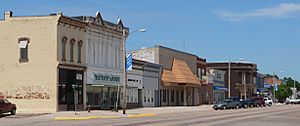Arapahoe, Nebraska facts for kids
Quick facts for kids
Arapahoe, Nebraska
|
|
|---|---|

Nebraska Avenue in Arapahoe, July 2010
|
|

Location of Arapahoe, Nebraska
|
|
| Country | United States |
| State | Nebraska |
| County | Furnas |
| Area | |
| • Total | 0.97 sq mi (2.52 km2) |
| • Land | 0.97 sq mi (2.52 km2) |
| • Water | 0.00 sq mi (0.00 km2) |
| Elevation | 2,179 ft (664 m) |
| Population
(2020)
|
|
| • Total | 1,002 |
| • Density | 1,031.93/sq mi (398.24/km2) |
| Time zone | UTC-6 (Central (CST)) |
| • Summer (DST) | UTC-5 (CDT) |
| ZIP code |
68922
|
| Area code(s) | 308 |
| FIPS code | 31-01780 |
| GNIS feature ID | 2393970 |
| Website | City of Arapahoe |
Arapahoe is a city in Furnas County, in the southern part of the state of Nebraska in the Midwestern United States. The population of the rural town was 1,026 at the 2010 census.
Geography
According to the United States Census Bureau, the city has a total area of 0.99 square miles (2.56 km2), all land.
Climate
| Climate data for Arapahoe, Nebraska (coordinates:40°14′47″N 99°57′06″W / 40.2463°N 99.9516°W, 1991-2020) | |||||||||||||
|---|---|---|---|---|---|---|---|---|---|---|---|---|---|
| Month | Jan | Feb | Mar | Apr | May | Jun | Jul | Aug | Sep | Oct | Nov | Dec | Year |
| Average precipitation inches (mm) | 0.42 (11) |
0.59 (15) |
1.17 (30) |
2.35 (60) |
3.61 (92) |
3.49 (89) |
3.81 (97) |
3.13 (80) |
1.79 (45) |
1.45 (37) |
0.84 (21) |
0.41 (10) |
23.06 (587) |
| Source: NOAA | |||||||||||||
History
In the spring of 1871, the Arapahoe Town Company was formed in Plattsmouth, Nebraska, under the leadership of Captain E. B. Murphy, for the purpose of establishing a settlement in the Republican River valley. The townsite was surveyed on July 18, 1871. It was named for the Arapaho tribe of Native Americans who occupied this area.
A post office was established in Arapahoe in 1872. A sawmill and gristmill were constructed on Muddy Creek, west of the town; the sawmill provided timber for early construction.
In 1873, Furnas County was organized by the state legislature, with Arapahoe designated as the county seat. The designation was challenged by Beaver City; an 1873 county election, followed by extensive litigation, moved the county seat to Beaver City in 1876.
The city's first newspaper was the Pioneer, established in 1879. In 1882, the Arapahoe Public Mirror was established to support the Democratic Party in the county. The Public Mirror is still in operation; in 1924, it absorbed the Holbrook Observer. In 1978, it acquired the Elwood Bulletin, which it continues to publish under that name.
The Arapahoe Telephone Company was established in 1904. In the 1930s, during the Great Depression, a WPA project constructed a swimming pool and solarium at the city park, which had been part of the city's original layout.
Demographics
| Historical population | |||
|---|---|---|---|
| Census | Pop. | %± | |
| 1880 | 470 | — | |
| 1890 | 734 | 56.2% | |
| 1900 | 701 | −4.5% | |
| 1910 | 901 | 28.5% | |
| 1920 | 894 | −0.8% | |
| 1930 | 1,017 | 13.8% | |
| 1940 | 1,002 | −1.5% | |
| 1950 | 1,226 | 22.4% | |
| 1960 | 1,084 | −11.6% | |
| 1970 | 1,147 | 5.8% | |
| 1980 | 1,107 | −3.5% | |
| 1990 | 1,001 | −9.6% | |
| 2000 | 1,028 | 2.7% | |
| 2010 | 1,026 | −0.2% | |
| 2020 | 1,002 | −2.3% | |
| U.S. Decennial Census | |||
2010 census
At the 2010 census, there were 1,026 people, 452 households and 258 families residing in the city. The population density was 1,036.4 per square mile (400.2/km2). There were 515 housing units at an average density of 520.2 per square mile (200.9/km2). The racial makeup was 95.2% White, 0.1% African American, 0.6% Native American, 0.3% Asian, 0.1% Pacific Islander, 2.2% from other races, and 1.5% from two or more races. Hispanic or Latino of any race were 4.4% of the population.
There were 452 households, of which 25.7% had children under the age of 18 living with them, 47.1% were married couples living together, 6.9% had a female householder with no husband present, 3.1% had a male householder with no wife present, and 42.9% were non-families. 40.9% of all households were made up of individuals, and 23.7% had someone living alone who was 65 years of age or older. The average household size was 2.21 and the average family size was 2.91.
The median age was 46.3 years. 24% of residents were under the age of 18; 6.2% were between the ages of 18 and 24; 17.9% were from 25 to 44; 28.3% were from 45 to 64; and 23.6% were 65 years of age or older. The gender makeup was 46.4% male and 53.6% female.
Notable person
- Arno B. Cammerer, third director of the U.S. National Park Service
See also
 In Spanish: Arapahoe (Nebraska) para niños
In Spanish: Arapahoe (Nebraska) para niños

